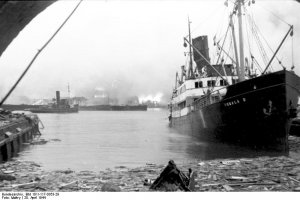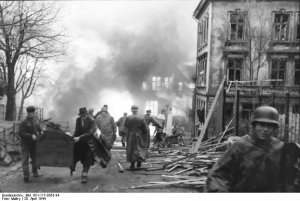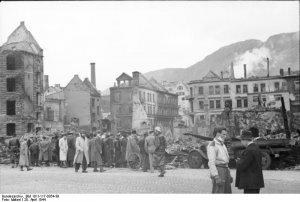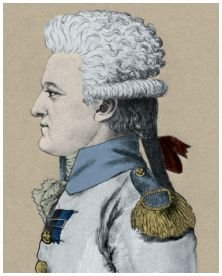Today in Naval History - Naval / Maritime Events in History
17th of April
some of the events you will find here,
please use the following link where you will find more details and all other events of this day .....
1683 – Launch of HMS Neptune, a 90-gun second-rate ship of the line of the Royal Navy.
She was built under the 1677 "Thirty Great Ships" Programme at Deptford Dockyard.
One of the old ladies - with 2 Re-launches she served more than 100 years
HMS Neptune was a 90-gun second-rate ship of the line of the Royal Navy. She was built under the 1677 "Thirty Great Ships" Programme and launched in 1683 at Deptford Dockyard.

Action of 18 October 1782 between HMS Torbay and London, and the 74-gun Scipion. Torbay is behind London
1780 - The Battle of Martinique, also known as the Combat de la Dominique, took place on 17 April 1780 during the American Revolutionary War in the West Indies between the British Royal Navy and the French Navy
The Battle of Martinique, also known as the Combat de la Dominique, took place on 17 April 1780 during the American Revolutionary War in the West Indies between the British Royal Navy and the French Navy.

Combat de la Dominique, 17 Avril 1780, by Auguste Louis de Rossel de Cercy (1736–1804)

Scale: 1:48. A contemporary full hull model of the ‘Centurion’ (1774), a 50-gun small two-decker. The model is decked and rests on a slipway. It has the name ‘Centurion’ painted on the stern. The figurehead depicts a centurion wearing a helmet. The ‘Centurion’ was built at Woolwich by Barnard & Co. and designed by Sir T. Slade. It measured 146 feet along the gun deck by 40 feet in the beam. Between 1775 and 1780, it served in the Caribbean taking part in the Battle of Martinique (1780). It then returned home and had its hull coppered – a relatively new technique employed to protect the underwater hull from the attack of marine boring worms, molluscs and weed growth. Between 1795 and 1805 the ‘Centurion’ served in the East Indies taking part in the Capture of Ceylon (1795) and was involved in Red Sea operations around Suez (1799–1800). It was broken up at Halifax, Nova Scotia, in 1825 having been a receiving ship there since 1809.
1797 – Sir Ralph Abercromby attacks San Juan, Puerto Rico, in what would be one of the largest invasions of the Spanish territories in the Americas.
The Battle of San Juan was a 1797 ill-fated British assault on the Spanish colonial port city of San Juan in Puerto Rico. The attack was carried out facing the historic town of Miramar.

The Fortín de San Gerónimo was key to the defense of San Juan.
1798 – Launch of HMS Pheasant, an 18-gun Merlin class sloop of the Royal Navy
HMS Pheasant was an 18-gun Merlin class sloop of the Royal Navy.
She was built in 1798 for the Royal Navy at a cost of £8,087 (equivalent to £836,200 in 2018).
From 1798 to 1803 she was based in Halifax, Nova Scotia.

1802 – Launch of french Belle Poule, a Virginie-class frigate of the French Navy, which was built by the Crucy family's shipyard at Basse-Indre to a design by Jacques-Noël Sané
HMS Belle Poule was a Royal Navy fifth rate frigate, formerly Belle Poule, a Virginie-class frigate of the French Navy, which was built by the Crucy family's shipyard at Basse-Indre to a design by Jacques-Noël Sané. She was launched on 17 April 1802, and saw active service in the East, but in 1806 a British squadron under Sir John Borlase Warren captured her off La Palma in the Canary Islands. The Admiralty commissioned her into the Royal Navy as HMS Belle Poule. She was sold in 1816.

Capture of the 'Gypsy', 30 April 1812: left to right: HMS Belle Poule, Gypsy, and HMS Hermes, by Thomas Buttersworth
1806 - HMS Sirius (36), Cptn. Prowse, took Bergere (18), Cptn. Chaney Duolvis, at Civita Vecchia.
HMS Sirius was a 36-gun fifth-rate frigate of the Royal Navy. Between 1797 and 1805, the Sirius was engaged in maintaining the blockade of Napoleonic Europe. She was lost in 1810 when her crew scuttled her after she grounded during the Battle of Grand Port.

Scuttling of Sirius
1809 – French Hautpoult, a Téméraire class 74-gun French Navy ship of the line, captured by her now-British sister ship, HMS Pompée, after a chase over three nights and two days by Pompée, Recruit, and Neptune.

Intrepid behaviour of Captain Charles Napier, in HM 18-gun Brig Recruit for which he was appointed to the Hautpoult. The 74 now pouring a broadside into her. April 15, 1809. Hautpoult can be seen in the background.
1810 – Launch of HMS Menelaus, a Royal Navy 38-gun fifth rate frigate, at Plymouth
HMS Menelaus was a Royal Navy 38-gun fifth rate frigate, launched in 1810 at Plymouth.

HMS Menelaus (ship in center) sailing with three other ships from a 19th century watercolor painting by artist, William Innes Pocock
1813 – Launch of HMS Cydnus, one of eight Royal Navy 38-gun Cydnus-class fifth-rates.
HMS Cydnus was one of eight Royal Navy 38-gun Cydnus-class (sub-class of Leda-class) fifth-rates. This frigate was built in 1813 at Blackwall Yard, London, and broken up in 1816.

1837 - Texan schooner Independence was one of the four schooners of the First Texas Navy captured during the Battle of Brazos River
The Battle of the Brazos River was an engagement fought in the Brazos River on April 17, 1837, between the Mexican Navy and the Texas Navy.
1855 – Launch of HMS Sutlej, a Constance-class 50-gun fourth-rate frigate of the Royal Navy

Gun deck on HMS Sutlej, circa. 1865-1868
1866 – Launch of HMS Northumberland, the last of the three Minotaur-class armoured frigates built for the Royal Navy during the 1860s.
She had a different armour scheme and heavier armament than her sister ships, and was generally regarded as a half-sister to the other ships of the class.
HMS Northumberland was the last of the three Minotaur-class armoured frigates built for the Royal Navy during the 1860s. She had a different armour scheme and heavier armament than her sister ships, and was generally regarded as a half-sister to the other ships of the class. The ship spent her career with the Channel Squadron and occasionally served as a flagship. Northumberland was placed in reserve in 1890 and became a training ship in 1898. She was converted into a coal hulk in 1909 and sold in 1927, although the ship was not scrapped until 1935.

Northumberland in her original 5-masted configuration
1866 – Launch of the passenger clipper Sobraon by Alexander Hall & Co. built the ship in Scotland - she was the largest composite-hull sailing vessel ever built,
later HMAS Tingira, a training ship operated by the Royal Australia Navy (RAN) between 1911 and 1927.
HMAS Tingira was a training ship operated by the Royal Australia Navy (RAN) between 1911 and 1927. Alexander Hall & Co. built the ship in Scotland in 1866 as the passenger clipper Sobraon; she was the largest composite-hull sailing vessel ever built. She sailed on an annual migration run between England and Australia until 1891, when she was sold to the colonial government of New South Wales for use as a reformatory ship. The vessel was then sold to the federal government in 1911, and entered RAN service. Tingira was paid off in 1927, but despite efforts to preserve the ship, was broken up in 1941.

HMAS Tingira moored in Rose Bay, Sydney in 1912
17th of April
some of the events you will find here,
please use the following link where you will find more details and all other events of this day .....
Naval/Maritime History - 17th of April - Today in Naval History - Naval / Maritime Events in History
Today in Naval History - Naval / Maritime Events in History 16 April 1767 - Birth of Richard Parker, later President of the "Floating Republic" at the Nore, Richard Parker (16 April 1767 – 30 June 1797) was an English sailor executed for his role as president of the so-called "Floating...
shipsofscale.com
1683 – Launch of HMS Neptune, a 90-gun second-rate ship of the line of the Royal Navy.
She was built under the 1677 "Thirty Great Ships" Programme at Deptford Dockyard.
One of the old ladies - with 2 Re-launches she served more than 100 years
HMS Neptune was a 90-gun second-rate ship of the line of the Royal Navy. She was built under the 1677 "Thirty Great Ships" Programme and launched in 1683 at Deptford Dockyard.
Action of 18 October 1782 between HMS Torbay and London, and the 74-gun Scipion. Torbay is behind London
1780 - The Battle of Martinique, also known as the Combat de la Dominique, took place on 17 April 1780 during the American Revolutionary War in the West Indies between the British Royal Navy and the French Navy
The Battle of Martinique, also known as the Combat de la Dominique, took place on 17 April 1780 during the American Revolutionary War in the West Indies between the British Royal Navy and the French Navy.
Combat de la Dominique, 17 Avril 1780, by Auguste Louis de Rossel de Cercy (1736–1804)
Scale: 1:48. A contemporary full hull model of the ‘Centurion’ (1774), a 50-gun small two-decker. The model is decked and rests on a slipway. It has the name ‘Centurion’ painted on the stern. The figurehead depicts a centurion wearing a helmet. The ‘Centurion’ was built at Woolwich by Barnard & Co. and designed by Sir T. Slade. It measured 146 feet along the gun deck by 40 feet in the beam. Between 1775 and 1780, it served in the Caribbean taking part in the Battle of Martinique (1780). It then returned home and had its hull coppered – a relatively new technique employed to protect the underwater hull from the attack of marine boring worms, molluscs and weed growth. Between 1795 and 1805 the ‘Centurion’ served in the East Indies taking part in the Capture of Ceylon (1795) and was involved in Red Sea operations around Suez (1799–1800). It was broken up at Halifax, Nova Scotia, in 1825 having been a receiving ship there since 1809.
1797 – Sir Ralph Abercromby attacks San Juan, Puerto Rico, in what would be one of the largest invasions of the Spanish territories in the Americas.
The Battle of San Juan was a 1797 ill-fated British assault on the Spanish colonial port city of San Juan in Puerto Rico. The attack was carried out facing the historic town of Miramar.
The Fortín de San Gerónimo was key to the defense of San Juan.
1798 – Launch of HMS Pheasant, an 18-gun Merlin class sloop of the Royal Navy
HMS Pheasant was an 18-gun Merlin class sloop of the Royal Navy.
She was built in 1798 for the Royal Navy at a cost of £8,087 (equivalent to £836,200 in 2018).
From 1798 to 1803 she was based in Halifax, Nova Scotia.
1802 – Launch of french Belle Poule, a Virginie-class frigate of the French Navy, which was built by the Crucy family's shipyard at Basse-Indre to a design by Jacques-Noël Sané
HMS Belle Poule was a Royal Navy fifth rate frigate, formerly Belle Poule, a Virginie-class frigate of the French Navy, which was built by the Crucy family's shipyard at Basse-Indre to a design by Jacques-Noël Sané. She was launched on 17 April 1802, and saw active service in the East, but in 1806 a British squadron under Sir John Borlase Warren captured her off La Palma in the Canary Islands. The Admiralty commissioned her into the Royal Navy as HMS Belle Poule. She was sold in 1816.
Capture of the 'Gypsy', 30 April 1812: left to right: HMS Belle Poule, Gypsy, and HMS Hermes, by Thomas Buttersworth
1806 - HMS Sirius (36), Cptn. Prowse, took Bergere (18), Cptn. Chaney Duolvis, at Civita Vecchia.
HMS Sirius was a 36-gun fifth-rate frigate of the Royal Navy. Between 1797 and 1805, the Sirius was engaged in maintaining the blockade of Napoleonic Europe. She was lost in 1810 when her crew scuttled her after she grounded during the Battle of Grand Port.
Scuttling of Sirius
1809 – French Hautpoult, a Téméraire class 74-gun French Navy ship of the line, captured by her now-British sister ship, HMS Pompée, after a chase over three nights and two days by Pompée, Recruit, and Neptune.
Intrepid behaviour of Captain Charles Napier, in HM 18-gun Brig Recruit for which he was appointed to the Hautpoult. The 74 now pouring a broadside into her. April 15, 1809. Hautpoult can be seen in the background.
1810 – Launch of HMS Menelaus, a Royal Navy 38-gun fifth rate frigate, at Plymouth
HMS Menelaus was a Royal Navy 38-gun fifth rate frigate, launched in 1810 at Plymouth.
HMS Menelaus (ship in center) sailing with three other ships from a 19th century watercolor painting by artist, William Innes Pocock
1813 – Launch of HMS Cydnus, one of eight Royal Navy 38-gun Cydnus-class fifth-rates.
HMS Cydnus was one of eight Royal Navy 38-gun Cydnus-class (sub-class of Leda-class) fifth-rates. This frigate was built in 1813 at Blackwall Yard, London, and broken up in 1816.
1837 - Texan schooner Independence was one of the four schooners of the First Texas Navy captured during the Battle of Brazos River
The Battle of the Brazos River was an engagement fought in the Brazos River on April 17, 1837, between the Mexican Navy and the Texas Navy.
1855 – Launch of HMS Sutlej, a Constance-class 50-gun fourth-rate frigate of the Royal Navy
Gun deck on HMS Sutlej, circa. 1865-1868
1866 – Launch of HMS Northumberland, the last of the three Minotaur-class armoured frigates built for the Royal Navy during the 1860s.
She had a different armour scheme and heavier armament than her sister ships, and was generally regarded as a half-sister to the other ships of the class.
HMS Northumberland was the last of the three Minotaur-class armoured frigates built for the Royal Navy during the 1860s. She had a different armour scheme and heavier armament than her sister ships, and was generally regarded as a half-sister to the other ships of the class. The ship spent her career with the Channel Squadron and occasionally served as a flagship. Northumberland was placed in reserve in 1890 and became a training ship in 1898. She was converted into a coal hulk in 1909 and sold in 1927, although the ship was not scrapped until 1935.
Northumberland in her original 5-masted configuration
1866 – Launch of the passenger clipper Sobraon by Alexander Hall & Co. built the ship in Scotland - she was the largest composite-hull sailing vessel ever built,
later HMAS Tingira, a training ship operated by the Royal Australia Navy (RAN) between 1911 and 1927.
HMAS Tingira was a training ship operated by the Royal Australia Navy (RAN) between 1911 and 1927. Alexander Hall & Co. built the ship in Scotland in 1866 as the passenger clipper Sobraon; she was the largest composite-hull sailing vessel ever built. She sailed on an annual migration run between England and Australia until 1891, when she was sold to the colonial government of New South Wales for use as a reformatory ship. The vessel was then sold to the federal government in 1911, and entered RAN service. Tingira was paid off in 1927, but despite efforts to preserve the ship, was broken up in 1941.
HMAS Tingira moored in Rose Bay, Sydney in 1912


 Drydock and Shipbuilding.
Drydock and Shipbuilding.



